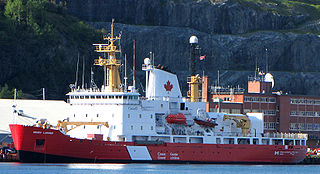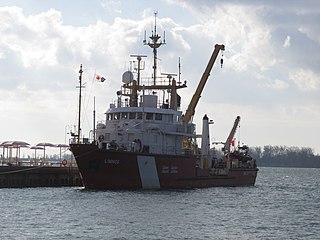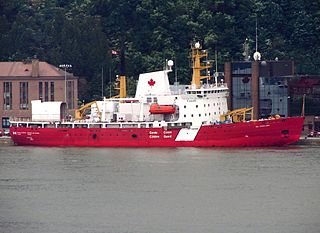
CCGS Henry Larsen is a Canadian Coast Guard Improved Pierre Radisson-class icebreaker serving in the Newfoundland and Labrador region and based in St John's, Newfoundland and Labrador. Entering service in 1988, Henry Larsen is the fourth ship and of an improved design over the rest of the ships in her class. The ship operates in the Arctic Ocean during summer months.

CCGS Samuel Risley is a Canadian Coast Guard icebreaker and buoy tender assigned to the Great Lakes area. Lead ship of her class, the vessel is named after Samuel Risley, the 19th century maritime inspector and first head of Board of Steamship Inspectors for Upper Canada and Ontario. Based in the Great Lakes, CCGS Samuel Risley is responsible for keeping an ice-free passage between Port Colborne, Ontario and Thunder Bay, Ontario.
CCGS Cape Roger is the lead ship of the Cape Roger-class fisheries patrol vessels operated by the Canadian Coast Guard. The ship entered service in 1977 and was assigned to monitor the Atlantic fisheries. During the Turbot War, Cape Roger took part in the detainment of the Spanish fishing trawler Estai. The ship is currently in service.

CCGS Labrador was a Wind-class icebreaker. First commissioned on 8 July 1954 as Her Majesty's Canadian Ship (HMCS) Labrador in the Royal Canadian Navy (RCN), Captain O.C.S. "Long Robbie" Robertson, GM, RCN, in command. She was transferred to the Department of Transport (DOT) on 22 November 1957, and re-designated Canadian Government Ship (CGS) Labrador. She was among the DOT fleet assigned to the nascent Canadian Coast Guard (CCG) when that organization was formed in 1962, and further re-designated Canadian Coast Guard Ship (CCGS) Labrador. Her career marked the beginning of the CCG's icebreaker operations which continue to this day. She extensively charted and documented the then-poorly-known Canadian Arctic, and as HMCS Labrador was the first ship to circumnavigate North America in a single voyage. The ship was taken out of service in 1987 and broken up for scrap in 1989.

CCGS Bartlett is a Provo Wallis-class buoy tender in operation by the Canadian Coast Guard. The vessel entered service in 1969 and was modernized in 1988. In 1982, the ship commanded the recovery efforts following the Ocean Ranger sinking off the coast of Newfoundland. The vessel is assigned to the Pacific Region and is based at Victoria, British Columbia.

CCGS John P. Tully is an offshore oceanographic science vessel in the Canadian Coast Guard operating out of Pacific Region at CGS Base Patricia Bay in Sidney, British Columbia. Prior to 1995, the ship was assigned to Fisheries and Oceans Canada. The vessel entered service in June 1985 with the Department of Fisheries and Oceans on the West Coast of Canada. In 1995, the fleets of Fisheries and Oceans and the Canadian Coast Guard were merged under Canadian Coast Guard command and John P. Tully became a Coast Guard vessel.

CCGS Hudson was an offshore oceanographic and hydrographic survey vessel operated by the Canadian Coast Guard. The ship entered service in 1963 with the Canadian Oceanographic Service, stationed at the Bedford Institute of Oceanography, called CSS Hudson. The ship made several significant scientific voyages, among them the first circumnavigation of the Americas in 1970. The ship was transferred to the Canadian Coast Guard in 1996 and decommissioned in 2022 due to non feasible upgrades and issues. A replacement is not scheduled for delivery until 2024–2025.

CCGS Alfred Needler is an offshore fishery science vessel operated by the Canadian Coast Guard. The vessel entered service in 1982 with the Department of Fisheries and Oceans, stationed at the Bedford Institute of Oceanography in Dartmouth, Nova Scotia. In 1995, in order to reduce the number of ships and combine tasks, the Fisheries and Oceans fleet and the Canadian Coast Guard fleets were merged under the Canadian Coast Guard. Alfred Needler is currently in service.

CCGS W.E. Ricker was a Canadian Coast Guard offshore fisheries research vessel. The ship was originally constructed as the commercial fishing trawler Callistratus, but was purchased by the Government of Canada in 1984 and converted to a fisheries research vessel and renamed W.E. Ricker. The vessel entered service with the Department of Fisheries and Oceans in 1986 and was transferred to the Canadian Coast Guard in 1995 after the two fleets were amalgamated. The ship was assigned to the West Coast of Canada and was decommissioned on 14 March 2017.

CCGS Limnos is a Canadian Coast Guard coastal research and survey vessel and it is named after the Greek island of Limnos which itself derived from "limni", the Greek word for lake. The ship entered service in 1968 and is currently active. The ship is based on the Great Lakes at the Coast Guard Base in Burlington, Ontario and is used for hydrographic and limnological research.
CCGS N.B. McLean was a Canadian Coast Guard icebreaker. Constructed in 1930 at Halifax Shipyards, she entered service as CGS N.B. MacLean and served in the Department of Transport's Marine Service, using the prefix "Canadian Government Ship". The ship was transferred into the newly created Canadian Coast Guard in 1962. She served in the St. Lawrence River and Gulf of St. Lawrence until she was decommissioned in 1979, and taken to Taiwan to be scrapped in 1989. She was replaced by CCGS Pierre Radisson.

CCGS Siyay is a Canadian Coast Guard Type 400 BHC AP1-88/400 hovercraft based in Richmond, British Columbia. The vessel was ordered in 1996 and launched and entered service in 1998. The hovercraft is predominantly used for servicing navigational aids and search and rescue duties.

CCGS Sipu Muin is a Canadian Coast Guard Type 400 AP1-88 air cushion vehicle (ACV) or hovercraft based at CCG Hovercraft Base Trois-Rivières in Trois-Rivières, Quebec. The vessel was launched and completed in 1998 and entered service the same year. Sipu Main is predominantly used for icrebreaking, search and rescue, and for servicing navigational aids in the Lower Saint Lawrence River and St. Lawrence Seaway.
CCGS Wilfred Templeman was a Canadian Coast Guard fisheries research vessel that entered service 1981 with the Department of Fisheries and Oceans. In 1995 the Fisheries and Oceans and Canadian Coast Guard fleets were amalgamated and Wilfred Templeman joined the Canadian Coast Guard. The research vessel patrolled the coast off Newfoundland and Labrador. In 2011, the vessel was taken out of service, sold to commercial interests and renamed Blain M.

CCGS Vector is a hydrographic survey vessel in the Canadian Coast Guard. The ship was constructed in Canada and entered service in 1967 as a coastal research vessel on the West Coast. The ship is currently in service, based at Canadian Coast Guard Base Patricia Bay in Sidney, British Columbia.

CCGS Tracy was a Marine service vessel and navigational aid tender operated by the Canadian Coast Guard. Designed for service on the Great Lakes and the Saint Lawrence River, the ship joined the fleet in 1968 and was stationed at Canadian Coast Guard Base at Sorel, Quebec and serviced the Quebec Region. The vessel was taken out of service in 2013 and was sold in 2017 to private interests.
CCGS Provo Wallis is a Provo Wallis-class buoy tender that served with the Canadian Coast Guard. The vessel entered service in 1969 and was classed as a Medium-endurance Multi-tasked Vessel. Provo Wallis spent the majority of her career on the Atlantic Coast of Canada before transferring to the West Coast. Ice-strengthened, the ship was used mainly for maintaining navaids in shipping lanes. The vessel was taken out of service in 2011 and laid up.

The Samuel Risley-class icebreakers are a class of two icebreakers and buoy tenders constructed for and operated by the Canadian Coast Guard. The two ships are based on offshore supply tugboat design and entered service in the 1980s. Samuel Risley is deployed to the Central Region, operating mainly on the Great Lakes of North America while Earl Grey is posted to Atlantic Canada, working off the east coast of Canada.

CCGS Tanu is a fisheries patrol vessel in service with the Canadian Coast Guard. The ship was constructed in 1968 by Yarrows at their yard in Esquimalt, British Columbia and entered service the same year. Home ported at Patricia Bay, British Columbia, the ship is primarily used to carry out fisheries patrols and search and rescue missions along Canada's Pacific coast.

The Pierre Radisson-class icebreakers, also known as R-class icebreakers, are a class of four icebreakers constructed for and operated by the Canadian Coast Guard. The Canadian Coast Guard designates the four ships in the class as medium icebreakers. Built in two phases, the first three ships, Pierre Radisson, Franklin and Des Groseilliers, were built to a common design. The fourth, Henry Larsen was built to a modified design and is considered a subclass, the Improved R-class icebreaker. Franklin was later renamed Sir John Franklin before undergoing a re-design for use primarily as an Arctic research vessel. Upon the vessel's return to service, the ship was once again renamed Amundsen. All the vessels are named for people who sailed through Canada's northern waters. The class operates in the Arctic Ocean in the summer, patrolling, icebreaking and research missions.
















